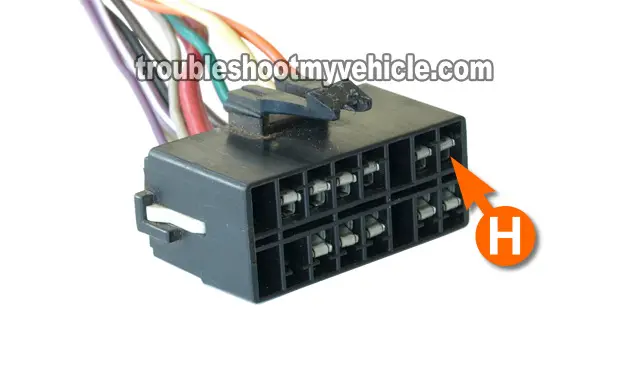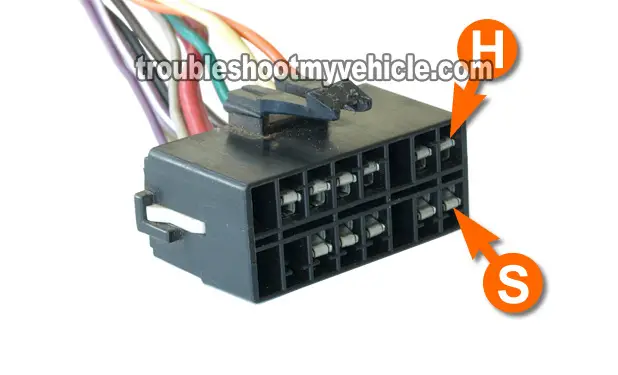TEST 3: Checking Power (Park Lamps Circuit)

This test and TEST 4 will help you diagnose a 'no park lights' Condition.
To be a bit more specific, this test (TEST 3) and TEST 4 will help to pinpoint the problem to the headlight switch or completely eliminate it as the cause of the 'no park lights' problem.
Now, in this TEST 3, you're gonna' check to see if the circuit that supplies the park lights with power (battery voltage) is actually feeding the headlight switch with power.
Once again, keep in mind several important things in mind when testing for these 12 Volts at the headlight switch connector:
- If you probe the front to the connector, be careful and don't damage the metal female terminal with the multimeter test lead.
- It's best to back probe the connector or use a wire piercing probe instead of probing the front of the headlight switch connector.
This is what you'll need to do:
- 1
Grab your multimeter and set it in Volts DC mode.
- 2
Probe the wire that corresponds to the circuit H (orange wire) with the red multimeter test lead. You can do this by either:
- Back probing the connector.
- Using a wire piercing probe (the method I use).
- Or gently touching the multimeter probe to the front of the connector.
- 3
Ground the black multimeter test lead on a good Ground point.
NOTE: Since you're working inside the vehicle, you may not have a handy Ground point to Ground the multimeter test lead, so I suggest using a battery jump start cable to Ground the black multimeter test lead directly to the battery negative (-) terminal. - 4
Your multimeter will register one of two things: battery voltage (12 Volts) or no voltage at all.
Voltage should be present whether the key is in the ON position (in the ignition switch) or not.
Let's take a look at what your test results mean:
CASE 1: The multimeter registered 12 Volts. So far so good, since this tells you that the circuit that controls the park lamps (inside the headlamp dimmer switch does have power). Go to: TEST 4: Fused Jumper Wire (Park Lamps Circuit).
CASE 2: The multimeter DID NOT register 12 Volts. Re-check your connections and re-test. If your multimeter still does not register battery voltage, then this tells you that a lack of battery voltage, in this circuit, is the principal reason that the park lights are not coming ON.
This test result also tells you that the headlight switch is not bad since without power in this circuit, it can not turn on the park lamps.
TEST 4: Fused Jumper Wire (Park Lamps Circuit)

So far in TEST 3, you have confirmed that Circuit H (Orange wire) is feeding battery voltage to the park lamp circuit of the headlight switch.
The next step now is to use a fused jumper wire to and manually jumper Circuit H (Orange wire) and Circuit S (Brown wire) together.
I recommend that you make your own fused jumper wire to use in this section but you don't have to. You can use just a piece of wire.
OK, this is what you'll need to do:
- 1
Disconnect the headlight switch from its harness connector.
- 2
Locate terminals H and S of the headlight switch connector.
- 3
Using a jumper wire, jumper terminals C and G together.
NOTE: Whatever you use to jumper these two female terminals together, be careful and do not damage them. By damage, I mean using something that will permanently open up the terminals and resulting in a false contact later with the male spade terminals of the headlight switch. - 4
The result that you should see is that the park lights should come ON.
Let's find out what your test results mean:
CASE 1: The park lights came ON. This tells you that the headlight switch is bad and needs to be replaced.
Here's why: So far you have verified:
- The park lights do not come ON when you activate the headlight switch.
- In TEST 3, you verified that battery voltage is being fed to the park lamp circuit (inside the switch) on the orange wire.
- In this test step, when you manually jumpered circuits H and S AND the park lights came ON.
Taking all 3 test results above into account, you now know beyond a shadow of a doubt that the headlight switch is bad. If you'd like to save some bucks on the headlight switch, go to: Where To Buy The Headlight Switch And Save.
CASE 2: The park lights DID NOT come ON. Re-check your connections and re-test.
If the park lights did not come ON, then you have eliminated the headlight switch as bad.
Although it's beyond the scope of this article to test for a short in the wiring between the headlight switch and the park lamps, this result tells you that there is an open-circuit in circuit S (brown wire).
Headlight Switch Test Summary
Hopefully this article helped you to find the repair solution to your 'no headlights' or 'no park lamps' problem on your GM pickup, van, mini-van, or SUV.
I know that this article is pretty narrow in its focus, since it only tests the headlight switch and nothing else. Therefore, I invite you to share your own troubleshooting and repair experience with the rest of this web page's readers. This not only improves the article, but will help anyone else with a similar issue or problem. You can use the contact form below.
More GM 4.3L, 5.0L, 5.7L Tutorials
You can find a complete list of tutorial in this index: GM 4.3L, 5.0L, 5.7L Index Of Articles.
Here's a sample of the tutorials you'll find in the index:
- How To Test The Blower Resistor (1988-1993 Pickups).
- How To Test The Blower Motor (GM 4.3L, 5.0L, 5.7L).
- How Can I Tell If My 4L60-E Transmission Is Bad?
- Shift Solenoid A And B Tests (GM 4.3L, 5.0L, 5.7L).
- How To Test The Engine Compression (GM 4.3L, 5.0L, 5.7L).
- How To Test The GM Distributor Mounted Ignition Module (at: easyautodiagnostics.com).

If this info saved the day, buy me a beer!

